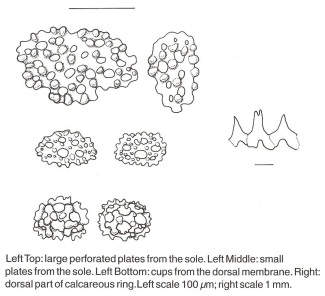Psolidium bidiscum was misidentified for many years as Psolidium bullatum Ohshima, but a detailed examination showed it to be an undescribed species. P. bullatum is known only from the Aleutian Islands and Gulf of Alaska. P. bidiscum is a small (1 to 3 cm), dome-shaped sea cucumber with mauve to pink, shinglelike plates on the top side; about 10 rows of scales between the mouth and the anus. Each plate has up to 13 knoblike bumps and up to 6 tiny tube feet protruding through pores in the plate. The flat sole has three rows of tube feet around the edge, made up of two rows of robust tube feet and one outer row of minute tube feet. A staggered row of tube feet runs down the centre of the sole. The 10 feeding tentacles, 8 equal and 2 smaller, are translucent white, with reddish-brown blotches. Many specimens have prominent reddish-brown bands near the bases of the two smaller tentacles.
Skin ossicles: two sizes of perforated plates in the ventral sole and cups in the dorsal membrane that covers the plates.
Similar SpeciesThere are two species similar to Psolidium bidiscum in our waters: Psolus chitonoides and Psolus squamatus. The most common, P. chitonoides, is bright red to orange, with red tentacles; it does not have minute tube feet piercing the dorsal scales. P. squamatus has white dorsal scales and white tentacles. Psolidium bidiscum and Psolus squamatus both occur in deeper water. P. bidiscum is also accessible by scuba, but the sediment-covered body is difficult to spot.
